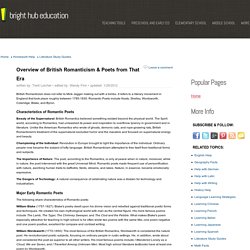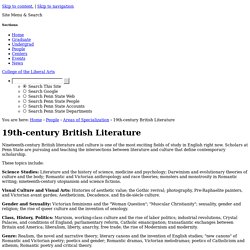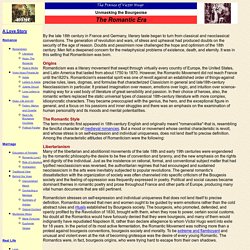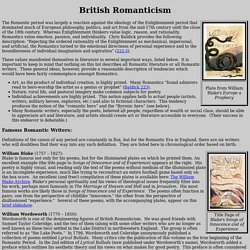

British Romanticism: Characteristics of Romantic Poets. Later Romantic Poets The following share characteristics of later Romantic poets: Lord Byron (1788-1824): Lord Byron enjoyed unmatched popularity.

Byron's most famous creations are his dark heroes, called Byronic heroes, who, in fact, were not heroes at all, but stood out from ordinary humans as larger than life. The Byronic hero brooded, possessed insatiable appetites and incredible strength, rebelled against societal norms, and forced upon himself exile. Byron's most famous works include Don Juan and Childe Harold's Pilgrimage. Percy Bysshe Shelley (1792-1822): Like all Romantics, Shelley was a radical non-conformist. John Keats (1795-1821): Perhaps the most popular Later Romantic poet, Keats accomplished great things during his short life. Want more? 19th-century British Literature — Department of English. Nineteenth-century British literature and culture is one of the most exciting fields of study in English right now.

Scholars at Penn State are pursuing and teaching the intersections between literature and culture that define contemporary scholarship. These topics include: Romanticism. In a Nutshell Ah, romance.

Bouquets of roses, Valentine's Day treats, smooching over a candlelight dinner… Okay, did you get that out of your system? Good. Because for the rest of this guide, you're going to throw all your associations with romance out the window and buckle down on what Romanticism is really about. That's' right: the Romantics were a group of poets writing and publishing in the late 18th and early 19th century in Britain—and their poetry didn't start with "roses are red. " Why do we call them "Romantics," then, if these guys weren't, you know, romantic?
What else set them apart? Nitty gritty aside, some of the greatest poets in the English language came out of this movement. We can't escape it nowadays. Untitled Document. By the late 18th century in France and Germany, literary taste began to turn from classical and neoclassical conventions.

The generation of revolution and wars, of stress and upheaval had produced doubts on the security of the age of reason. Doubts and pessimism now challenged the hope and optimism of the 18th century. Men felt a deepened concern for the metaphysical problems of existence, death, and eternity. It was in this setting that Romanticism was born. Origins Romanticism was a literary movement that swept through virtually every country of Europe, the United States, and Latin America that lasted from about 1750 to 1870. The Romantic Style The term romantic first appeared in 18th-century English and originally meant "romancelike"-that is, resembling the fanciful character of medieval romances. Romanticism stresses on self-expression and individual uniqueness that does not lend itself to precise definition. Romancticism - Literature Periods & Movements. Literature Network » Literary Periods » Romancticism No other period in English literature displays more variety in style, theme, and content than the Romantic Movement of the eighteenth and nineteenth centuries.

Furthermore, no period has been the topic of so much disagreement and confusion over its defining principles and aesthetics. Romanticism, then, can best be described as a large network of sometimes competing philosophies, agendas, and points of interest. In England, Romanticism had its greatest influence from the end of the eighteenth century up through about 1870. Its primary vehicle of expression was in poetry, although novelists adopted many of the same themes. First and foremost, Romanticism is concerned with the individual more than with society. On the formal level, Romanticism witnessed a steady loosening of the rules of artistic expression that were pervasive during earlier times. The master of symbolism in American literature was Nathaniel Hawthorne.
English literature. British Romanticism. The Romantic period was largely a reaction against the ideology of the Enlightenment period that dominated much of European philosophy, politics, and art from the mid-17th century until the close of the 18th century.

Whereas Enlightenment thinkers value logic, reason, and rationality, Romantics value emotion, passion, and individuality. Chris Baldick provides the following description: “Rejecting the ordered rationality of the Enlightenment as mechanical, impersonal, and artificial, the Romantics turned to the emotional directness of personal experience and to the boundlessness of individual imagination and aspiration” (222-3).
These values manifested themselves in literature in several important ways, listed below. It is important to keep in mind that nothing on this list describes all Romantic literature or all Romantic writers. These general ideas, however, provide a reasonable description of tendencies which would have been fairly commonplace amongst Romantics. Links: